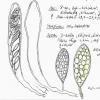
21-06-2010 22:49
 Hans-Otto Baral
Hans-Otto Baral
Hi I have here perithecia on Deschampsia leaves wh

21-06-2010 00:40
 Yannick Mourgues
Yannick Mourgues
Bonjour à tous. Connaissez-vous cet étrange asc

20-06-2010 19:51
Marja PennanenHello, once again I'm in trouble... These Hymeno

20-06-2010 12:15
 Yannick Mourgues
Yannick Mourgues
Salut à tous. Sur écorce de Larix, ce Mytilin

19-06-2010 14:40
Gernot FriebesHi, I have no idea about this pyreno, maybe you

19-06-2010 11:45
Marja PennanenHello, I found these on the bark of Picea and onc

18-06-2010 05:35
 Beñat Jeannerot
Beñat Jeannerot
Bonjour à tous, Dans le cadre d'une publicatio
pyreno on Deschampsia
Hans-Otto Baral,
21-06-2010 22:49
 Hi I have here perithecia on Deschampsia leaves which are covered by a dense silver-greybrown felt, without setae. Size not stated. The drawing is by the finder,
Hi I have here perithecia on Deschampsia leaves which are covered by a dense silver-greybrown felt, without setae. Size not stated. The drawing is by the finder,
Hans-Otto Baral,
21-06-2010 22:53
Alain GARDIENNET,
22-06-2010 13:13
Re: pyreno on Deschampsia
Hi Zotto,
it would be better if you can see it. Your first thought was not a bad idea.
Alain
it would be better if you can see it. Your first thought was not a bad idea.
Alain
Peter Welt,
22-06-2010 13:39

Re: pyreno on Deschampsia
Hi Zotto,
ich denke das ist Schizothecium glutinans unreif. Ich habe Klaus auch schon geschrieben. Schizothecium deswegen, da die Sporen schon septiert sind, das ist bei Podospora erst später der Fall.
Bis zur nächsten Lieferung von Bernd :-) Gruß Peter
ich denke das ist Schizothecium glutinans unreif. Ich habe Klaus auch schon geschrieben. Schizothecium deswegen, da die Sporen schon septiert sind, das ist bei Podospora erst später der Fall.
Bis zur nächsten Lieferung von Bernd :-) Gruß Peter
Hans-Otto Baral,
22-06-2010 17:11

Re: pyreno on Deschampsia
Danke, Peter! das wäre also ein Koprophiler?! Hier ein Fund von Bruno Coue:
http://www.ascofrance.fr/index.php?r=bdd&page=fiche&id=1350
Zotto
http://www.ascofrance.fr/index.php?r=bdd&page=fiche&id=1350
Zotto

